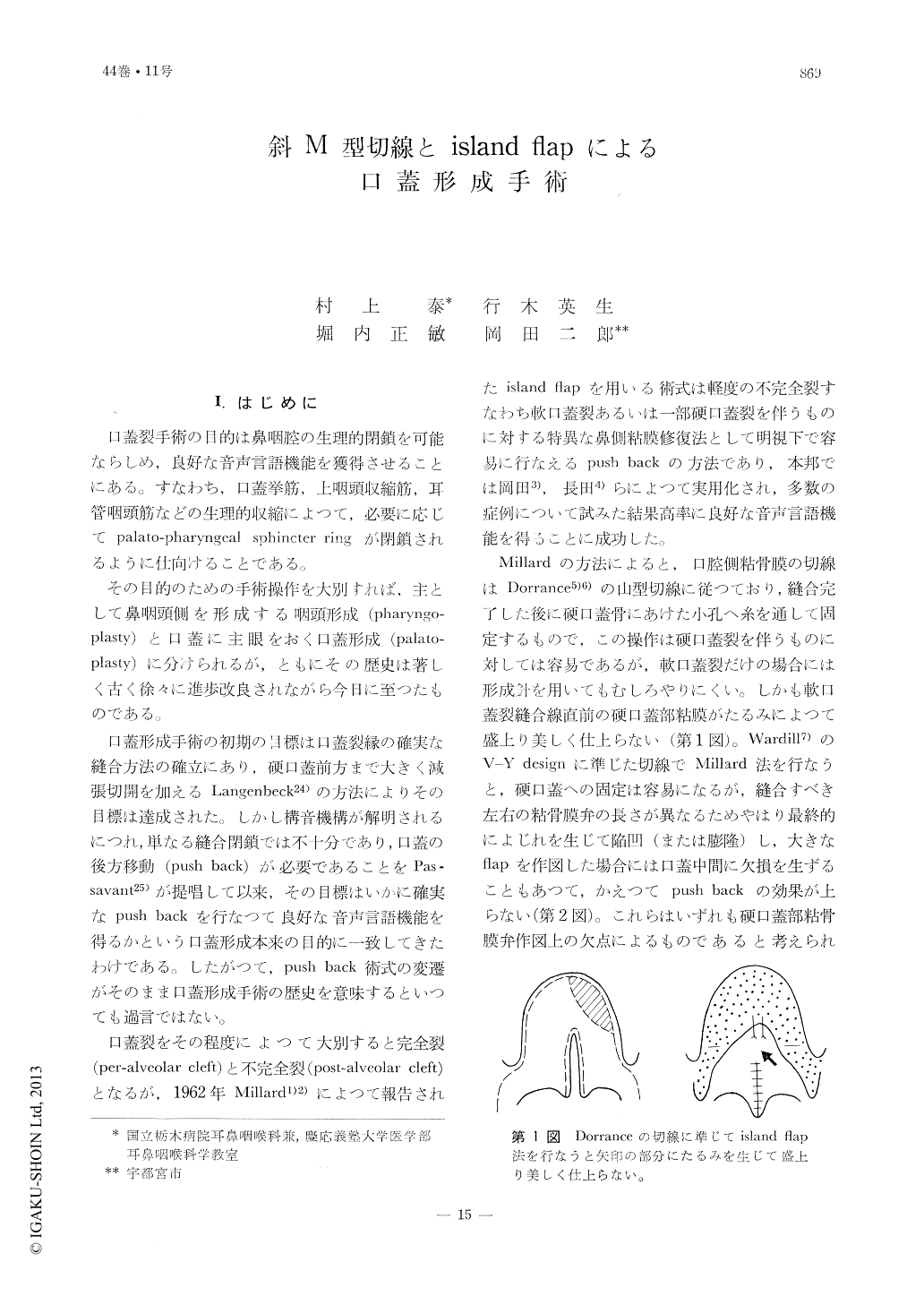Japanese
English
- 有料閲覧
- Abstract 文献概要
- 1ページ目 Look Inside
I.はじめに
口蓋裂手術の目的は鼻咽腔の生理的閉鎖を可能ならしめ,良好な音声言語機能を獲得させることにある。すなわち,口蓋挙筋,上咽頭収縮筋,耳管咽頭筋などの生理的収縮によつて,必要に応じてpalato-pharyngeal sphincter ringが閉鎖されるように仕向けることである。
その目的のための手術操作を大別すれば,主として鼻咽頭側を形成する咽頭形成(pharyngoplasty)と口蓋に主眼をおく口蓋形成(palatoplasty)に分けられるが,ともにその歴史は著しく古く徐々に進歩改良されながら今日に至つたものである。
口蓋形成手術の初期の目標は口蓋裂縁の確実な縫合方法の確立にあり,硬口蓋前方まで大きく減張切開を加えるLangenbeck24)の方法によりその目標は達成された。しかし構音機構が解明されるにつれ,単なる縫合閉鎖では不十分であり,口蓋の後方移動(push back)が必要であることをPassavant25)が提唱して以来,その目標はいかに確実なpush backを行なつて良好な音声言語機能を得るかという口蓋形成本来の目的に一致してきたわけである。したがつて,push back術式の変遷がそのまま口蓋形成手術の歴史を意味するといつても過言ではない。
口蓋裂をその程度によつて大別すると完全裂(peralveolar cleft)と不完全裂(postalveolar cleft)となるが,1962年Millard1)2)によつて報告されたisland Aapを用いる術式は軽度の不完全裂すなわち軟口蓋裂あるいは一部硬口蓋裂を伴うものに対する特異な鼻側粘膜修復法として明視下で容易に行なえるpush backの方法であり,本邦では岡田3),長田4)らによつて実用化され,多数の症例について試みた結果高率に良好な音声言語機能を得ることに成功した。
Millardの方法によると,口腔側粘骨膜の切線はDorrance5)6)の山型切線に従つており,縫合完了した後に硬口蓋骨にあけた小孔へ糸を通して固定するもので,この操作は硬口蓋裂を伴うものに対しては容易であるが,軟口蓋裂だけの場合には形成針を用いてもむしろやりにくい。しかも軟口蓋裂縫合線直前の硬口蓋部粘膜がたるみによつて盛上り美しく仕上らない(第1図)。Wardill7)のV-Ydesignに準じた切線でMillard法を行なうと,硬口蓋への固定は容易になるが,縫合すべき左右の粘骨膜弁の長さが異なるためやはり最終的によじれを生じて陥凹(または膨隆)し,大きなflapを作図した場合には口蓋中間に欠損を生ずることもあつて,かえつてpush backの効果が上らない(第2図)。これらはいずれも硬口蓋部粘骨膜弁作図上の欠点によるものであると考えられる。もつとも,術直後にみられるよじれや凹凸は術後3週程で平面化されるので特に問題とするにあたらないと主張するむきもあるが,それだけ術創の治癒が遅れ,肉芽の増殖とそれに伴う瘢痕収縮の程度も多少なりとも強くなるものと危惧される。
そこでわれわれは,硬口蓋部粘骨膜の切線について工夫し,斜M型切線によつてflapを作図する方法を考案し,過去1年間に16例について試みた結果,容易に満足すべきpush backを行ない得たのでその方法の概略を報告する。
The authors report 16 cases of cleft palate in which corrections were made by employment of push-back palatoplasty with an island flap by means of oblique M mucoperiosteal incision. The operations were performed during the past 1 year. The essential points of this technic are as follows;
1. The incision for the oral mucoperiosteal flap takes the shape of an olique M. The tip portion of the smaller flap is employed as an island flap resurfacing the raw area of the nasal floor.
2. Under this regimen the length of the edge of one mucoperiosteal flap becomes similar to that of another after detaching an island flap.
3. No special elevator was required to strip off the mucosal lining on the nasal floor, since only a small portion is needed to anchor the island flap.
4. The oral mucoperiostium is easily fixed to the midpoint of the hard palate, because it is sutured to the longer edge of the M.
5. The suture lines of the oral flaps appear to be slightly curved in the final stages. However, slackening or distortions of the oral flaps had never occurred in any case, because the tension of the mucoperiostium is even on both sides. This fact is highly important not only to facilitate an early and smooth wound healing but also, for maintainance of normal speech function.

Copyright © 1972, Igaku-Shoin Ltd. All rights reserved.


